- Home
- G. E. Nolly
Frag Order: Enemy Inside The Gate Page 9
Frag Order: Enemy Inside The Gate Read online
Page 9
As he tried to move forward by pulling on the edge of the right seat, the right seat also broke free and flew to the back of the cockpit. At the same time, the full forward control yoke directed the airplane down, and Sully was momentarily weightless as the airplane pitched from a climb into a steep dive. Sully found himself slowly floating toward the front of the cockpit, and he reached out to grab something, anything, to pull himself forward.
His right hand found the whiskey compass. The standby compass, colloquially called the whiskey compass, was the backup compass mounted at the center top of the windscreen, to be used as a alternate heading indicator. The instrument had received its name back in the early days of aviation, when it contained a compass card suspended in fluid. Originally it had been filled with whiskey, although it was now a different liquid.
Sully pulled himself forward with his right arm and grabbed the control yoke with his left to maneuver the airplane, which was now dangerously nose low at an altitude of about 300 feet. The airplane was pointed directly at the far end of the runway, and Sully gently pulled back on the yoke. If he pulled too quickly, the airplane would stall, but if he didn't pull hard enough, it would crash into the runway.
He didn't pull hard enough. The airplane main gear slammed into the runway at the same time the front propeller tore into the tarmac, and then the airplane bounced back into the air, vibrating and shuddering violently. Sully's head was pushed down onto the throttle quadrant. His chin forcefully hit the throttle quadrant and his knees slammed onto the cockpit floor. He held firmly onto the whiskey compass and knelt on his knees, frantically trying to control the airplane. He tasted blood, and his tongue found what felt like two chicklets in his mouth. They were his front teeth.
The Skymaster was flying again, but not very well. The front engine was shaking violently and loudly knocking. The entire airplane was shuddering. But, at least, it was still flying.
Holding onto the whiskey compass with his right hand, Sully momentarily released the yoke and pulled the front propeller control to the FEATHER position, stopping the engine. Then, after correcting the aircraft attitude by again manipulating the yoke, he reached up with his left hand and punched the guarded EXTERNAL STORES JETTISON button in the center of the instrument panel.
The two fully-loaded LAU-59 rocket pods dropped from the wings of the airplane, and tumbled onto the minefield that extended off the end of Runway 20 L. As the rocket pods left the airplane, the now-lighter Skymaster started an immediate climb. And then the mines started cooking off.
The explosions from the mines, triggered by the rocket pods, were good news/bad news for Sully. The concussion from the mines below actually rocked the Skymaster upward. At the same time, shrapnel from the exploding mines pierced the aircraft, peppering it with numerous fragments.
Sully felt a rush of air, and saw a large hole in the floor of the airplane, directly below his knees, and a corresponding hole in the cockpit roof. He checked the family jewels, discovered that he hadn't been hit, and continued flying the airplane.
Although Sully had feathered the front propeller, it was not streamlined with the airflow, and was now slowly turning. The propeller blades were bent backwards, looking very much like the remnants of an exploding cigar from a novelty trick Sully had seen as a kid. The airplane was gradually climbing, perhaps 200 feet per minute, and Sully started a gentle left turn. He rolled out on a northerly heading, finally at the normal 700-foot traffic pattern altitude.
His helmet microphone cord had become disconnected when his seat had tumbled back, and now, with the airplane finally in level flight, he was able to momentarily release his grip on the yoke and whiskey compass and plug his microphone cord into the connector. He reached over to the Transmit switch on the left horn of the yoke.
“Mayday, mayday, mayday. Covey 513 on downwind, engine failure and structural problems. I will be stopping straight ahead on runway 20 Left. Require medical assistance.”
“Roger, Covey 513,” the tower controller answered, “cleared to land any runway, emergency vehicles are responding.”
“Thank you.”
With the airplane now level, Sully looked around to see if he could find a better way to control the airplane than kneeling on his knees. He spotted a green ammo box fastened to the side wall at the rear of the cockpit. The 12-inch high ammo box held the smoke grenades used as backup target marks for times when the FAC might run out of willie pete rockets.
Sully released the ammo box bracket and put the box on the cockpit floor, directly behind the throttle quadrant. Then he removed his parachute and placed it on top of the ammo box.
“This will have to do for a place to sit,” he mumbled, as he sat on the makeshift seat and straddled the throttle quadrant. He stretched out his legs, putting his right foot on the left rudder pedal of the right seat controls, and his left foot on the pilot side right rudder pedal. He wasn't overly concerned about maintaining coordinated flight. His main concern was being able to operate the rudder pedals to steer the aircraft once it was on the runway, as well as being able to step on the brakes.
He was going to need to step with his right foot to turn left, and with his left foot to turn right. He held onto the top of the glare shield with his right hand, flew the airplane with his left hand, and practiced making some shallow turns. It was different, much different, trying to stay coordinated. Then it occurred to him that steering with his feet this way was exactly like steering a sled.
When he was a kid, Sully and his parents used to visit his maternal grandparents every other Christmas at their home in Wilmington, Delaware. During one visit, there was a lot of snow on the ground, and his grandfather took him into the garage.
“Do you know what this is?” his grandfather asked, taking a Lightning Glider sled down from a rack on the garage wall.
“No.”
“It's a sled, made for weather just like this. Here, I'll show you how to use it.”
Then his grandfather took him to the top of a steep hill a few blocks from their home, right near Warner Junior High. The hill was named Monkey Hill because of its proximity to the Wilmington zoo, which was located right at the base. Grandfather showed him how to steer the sled. Push with the left foot to turn right, push with the right foot to turn left. Young Sully made run after run down Monkey Hill, with his grandfather pulling him up the hill after each run. And he learned to steer the sled.
At the normal position for a base turn, Sully entered a shallow left bank, leaving his flaps in the takeoff position, since he didn't want to risk possibly getting asymmetrical flaps due to battle damage. The landing gear had been down since takeoff, so there was little to do other than fly the airplane.
He landed on runway 20 L and kept the aircraft centered on the runway as he brought it to a stop. The ambulance was at the plane as soon as he shut down the rear engine, and Sully’s Ops Officer, Major Spike Spillane, was there also. As the medics were attending to Sully, Spike looked inside the cockpit and saw the ammo box and parachute.
“Nice seat you made for yourself, Sully. Any problem steering?”
“No sir.” he said with a noticeable lisp, “Just like a sled.”
15
May 29, 1969
DaNang Air Base, South Vietnam
In the hubbub of activity at the Freedom Hill Amphitheater, no one seemed to notice the tall civilian contractor who was walking around, surveying the premises, and occasionally jotting something on his clipboard. He might have been part of the crew that had arrived to assist with reconstruction after the bomb blast a month earlier. He may have been a supervisor. He could have been anyone needed for the operation. By this time, Triad was skilled at appearing as whoever he wanted to be.
He found his target. The spotlights. He would use the spotlights to detonate the vx ampules. If he could attach a vial to each spotlight, the intense heat from the bulbs would cause the glass vials to shatter, and the vx gas would be aerosolized.
Obtaining the lethal nerve ag
ent hadn’t been easy, but was not as difficult as he had first imagined. Ideally, he would have gotten it before the blast, and it wouldn’t have been missed, but it had been impossible to gain access to the Marine facility. Now, the new bomb dump was bustling with construction crews, delivery personnel, and transfers. No one even checked his clearance level when he accessed the underground facility and acquired the most lethal ordnance: vx nerve gas. He simply put three vials in his pants pocket and walked out of the facility.
“If anybody bumps into me now,” he thought to himself, “we’re both toast.”
The vx nerve agent had never yet been used in combat. Its very existence had been denied repeatedly by the military brass, but they knew they might someday need it to save American lives, as a last resort. Even a small amount would do the job just fine. One drop on the skin would cause vomiting, diarrhea, breathing constriction, and eventually, death.
He unplugged all three spotlights from the outlets at the periphery of the stage floor and climbed the ladder to the catwalk.
He made his way over to the first spotlight and carefully, very carefully covered one vial in masking tape and wrapped the tape around the spotlight bulb. Each vial was securely fastened to it’s respective spotlight. Then he plugged the spotlight power cords back into the nearby outlets.
Everything was set for the big show.
1430L, May 30, 1969
Cam Ranh Air Base, South Vietnam
Guns Navarone had been talking on the autovon to Colonel Arthur Rhodes, the Wing Commander at Cam Ranh, for several days. He was following up on a Sergeant whose name had shown up on the list of missing personnel from Cam Ranh and was also one of the anagrams. At Navarone’s request, Colonel Rhodes had located the A-4 bag with the personal effects of Staff Sergeant Steve Winklar. He was holding the bag in his office, waiting for Guns to get to Cam Ranh to retrieve it. Guns had arranged for a solo F-4 “proficiency” flight, on an out-and-back mission to Cam Ranh.
“Hi, Dusty,” Guns greeted him, extending his hand, “Thanks a lot for locating his belongings.”
“Glad to help, Guns. I think I owed you a favor, anyway,” he said, unconsciously rubbing his left arm, the arm that had been injured in Korea on the day Guns had saved his life, “So what’s the deal with this stuff?”
“I think this Winklar guy might be involved in a case being investigated at DaNang.”
“What’s he done?”
“There’s reason to believe he might be directly involved with the Triad attacks. Won’t really know until I look through his bags and see what I can find.”
“Triad! I wish I didn’t have to go to a staff meeting soon because I would love to help catch that bastard. I have something to show you.”
Colonel Rhodes strode over to the corner of his office and retrieved an A-4 bag. He reached inside and withdrew the remains of a parachute. The canopy had several large knots tied in it.
“A Green Beret brite-light team was inserted into Laos to search for one of our pilots who was shot down on Christmas day. They located his remains and found this. When he ejected, he didn’t have a chance. His parachute was sabotaged by the same guy you’re looking for. Later, we found the trademark doll in the parachute shop.”
“Damn,” Guns said, “Sorry to hear that.”
“Nelson was our best IP. On his last mission before R&R.” Rhodes looked down at his feet and took a deep breath. “His family was already in Hawaii. I had to call Fort DeRussy and find a chaplain to break the news to them. Really shitty.” There was a long silence as Rhodes thought back of the difficult time. “Anyway, Guns, my office is yours. If you need anything, Sergeant Whitcomb, in the outer office, will take care of you.”
“Thanks, Dusty.”
As Colonel Rhodes left the office, Guns opened the A-4 bag and started looking through the contents. There wasn’t much that was remarkable. A few sets of fatigues, a civilian contractor uniform, three issues of Playboy magazine, and a cheap Kodak camera. Then Guns found the items that sealed the deal: a 1968 page-per-month calendar with dates circled, and three official-looking identification cards with different names. Walter S. Nevik, Kevin Walters, Steve Winklar. At least now he knew what Triad looked like.
Guns flipped through the 1968 calendar and noted the circled dates: May 30, July 4, August 30, October 13, October 31, December 25.
Guns tore through the bag, hoping to find a 1969 calendar. Nothing. As he was putting the 1968 calendar aside, he noticed a series of numbers scrawled on the back. The first line of numbers was 4.6, followed by 4.27, and then 5.30 directly below it. What did these numbers represent?
They didn’t appear to be GEOREF coordinates. Perhaps they represented times, or dates. He looked through the 1968 calendar and flipped to April to see if April 27th had anything annotated. It didn’t.
Then he ran to the outer office and turned to Sergeant Whitcomb.
“What day was Easter this year?”
The Sergeant looked through his desk calendar.
“It was on April sixth, sir.”
That was it - it was this Easter! And 4.27, April 27th, was the day of the bomb dump explosion. So 5.30 would be today, Memorial Day!
Guns had to get a call through to his nephew, and he had to get the Air Police looking for Triad. He grabbed the IDs and ran to the Cam Ranh Command Post. He repeatedly buzzed at the door, and addressed the Officer In Charge as soon as it opened.
“Major, I need you to fax these ID cards to the Air Police unit at DaNang and have them find this guy. And I need a secure line to DaNang ASAP. Priority One!”
“Yes, sir. This way.” The Major took the ID cards and handed them over to a Sergeant who had been listening. The Sergeant gave him a nod and ran over to the fax machine. The Major led him to a small booth lined with acoustical tile. Guns entered, and the door closed behind him with a muffled thud.
After a few minutes of telephone tag, he reached David Rice.
“Donny, this is your uncle. I’m at Cam Ranh right now, and I think I’ve identified Triad. I faxed his photo to the Air Police. I figured out when he’s going to launch his big attack.”
“I’m ahead of you, sir. I’ve alerted the APs and the MPs on Marine side to be ready for the Fourth of July.”
“No, it’s going to be sooner. I found a calendar of his with today’s date on it.”
“Holy shit! Did you find anything indicating where he’s going to attack? Am I securing the amphitheater or the runway complex?”
“You need to make that call. I’ll be back at DaNang in about an hour and I’m going to shut down all flight operations. In the mean-time, cancel that fucking show!”
16
October 31, 1968
Ho Chi Minh trail, Laos
Spike Spillane had located a lucrative target in the vicinity of Delta 21. He was on a late-morning mission, out of Cam Ranh, and something glinting in the sun had caught his eye. He decided it deserved a closer look.
Flying in an OV-10 was a real advantage over the O-2A. Unlike the Skymaster, the Bronco had turboprop engines and, more important, ejection seats. And it could fly twice as fast. It was the perfect airplane for flying low over a target to get a good look and still be able to quickly climb back to a safe altitude to control an airstrike.
Spike kept his engines at full power as he dove towards the target area, reaching his maximum speed as he flew directly over the target at less than 200 feet. There was no enemy reaction, and he pulled up to 4000 feet above the target and tried to assimilate what he'd just seen.
There, in the middle of the jungle, was a series of utility poles connecting transmission lines. It looked like the telephone wires that lined the streets near his home in Castle Rock. Telephone lines! He made a wide sweeping turn as he surveyed the area with his gyro-stabilized binoculars. The wires were almost invisible unless they were viewed from just the right angle, and at exactly the right time of day. They had emanated from the edge of the jungle, stretched across a large open field, and disa
ppeared into the jungle on the other side.
The lines would most likely terminate at some sort of command facility, and Spike was determined to find it. He made another pass, this time at less than 100 feet, following the wires back into the jungle. And then he saw it. A large hut with a thatched roof, virtually invisible under the triple-canopy jungle. The wires went into the hut, and did not come out the other side.
As if to confirm that this was an important target, he started receiving ZPU and ZSU-23-4 fire as he pulled off from his pass.
“Yes,” he said to himself, “they're protecting something.”
He selected his transmitter to VHF.
“Hillsboro, Covey 534.”
“Go ahead 534.”
“I've located a command post and need immediate air. Send them to Delta 21.”
“Roger,” there was a short pause, “I'm sending Gunfighter 71 flight to you. ETA five minutes. Strike frequency Kay-beck.”
Spike looked at his line-up card, located frequency Quebec, and channelized his UHF radio. After a short wait the fighters checked in.
“Covey 534, this is Gunfighter 71, flight of four fox fours, Mark 82's and CBU 52s, fifteen minutes playtime. Overhead Delta 21 this time, angels twenty-four. Trick or treat.”
“Roger Gunfighter. I have you in sight. I'm at your left seven o'clock at angels seven. The trick is to destroy a command post just inside the jungle at the edge of a large field off my left wing. Your treat will be great BDA. Wind calm, target elevation 4600 feet. You'll be cleared in from any direction. I'm in for the mark.”
Scooter armed the rocket pod on his left sponson and smoothly pulled the nose of his aircraft up as he rolled into a 135-degree left bank, to set up for a 45-degree delivery. As he passed through 90 degrees of bank, he pulled his throttles to IDLE.
Suddenly, Spike was violently thrown forward in his seat as the aircraft shuddered, snapped to the left and entered an inverted spin.

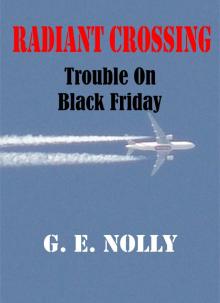 Radiant Crossing
Radiant Crossing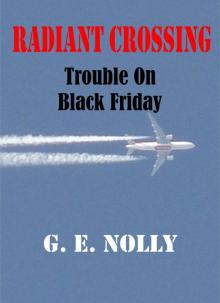 Radiant Crossing: Trouble On Black Friday (The Adventures of Hamilton Hamfist Hancock Book 5)
Radiant Crossing: Trouble On Black Friday (The Adventures of Hamilton Hamfist Hancock Book 5)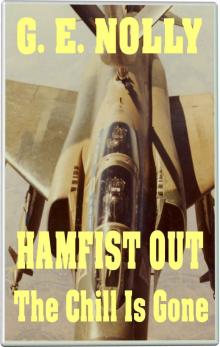 Hamfist Out: The Chill Is Gone (The Air Combat Adventures of Hamilton Hamfist Hancock Book 4)
Hamfist Out: The Chill Is Gone (The Air Combat Adventures of Hamilton Hamfist Hancock Book 4)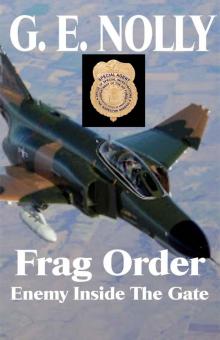 Frag Order: Enemy Inside The Gate
Frag Order: Enemy Inside The Gate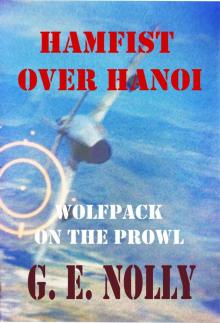 Hamfist Over Hanoi: Wolfpack on the Prowl (The Air Combat Adventures of Hamilton Hamfist Hancock Book 4)
Hamfist Over Hanoi: Wolfpack on the Prowl (The Air Combat Adventures of Hamilton Hamfist Hancock Book 4)